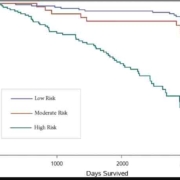Fatemeh Rezaei, Mozhgan Seif, Abdullah Gandomkar, Mohammad Reza Fattahi & Jafar Hasanzadeh*
Cardiovascular Diseases (CVDs) are one of the leading causes of death globally1. The annual mortality of CVDs has been predicted to increase from 17.5 million in 2012 to 22.2 million by 2030. Then, CVDs would be the number one cause of death and disability worldwide2. In Iran, the share of non-communicable diseases in mortality increased from 57% in 1990 to 76% in 20103,4 mostly due to ischemic heart disease, stroke, and other vascular diseases, which are generally considered CVDs5. Most of the deaths related to CVDs are premature and preventable and can be improved using health management, effective diets, lifestyle interventions, and medication interventions6. A useful method to prevent CVDs is to assess the risk of CVDs regularly and to modify the lifestyle or the clinical treatment accordingly. Since the treatment of these diseases imposes heavy burdens and high costs on healthcare systems7, their early diagnosis and appropriate treatment have significant health benefits for patients with the highest absolute risk of CVDs8.
Methods
Methods Pars cohort study design. This cross-sectional study was conducted using the baseline data of Pars cohort study. Pars cohort study is a part of the Persian Prospective Epidemiological Research Studies in Iranian Adults (PERSIAN) program. PERSIAN cohort study was designed and implemented in 2014 and included 18 different geographical, ethnic, and climatic groups in 18 provinces of Iran17. Details of the Pars cohort study have already been published18. Briefly, it was conducted on 9,264 individuals aged 40–75 years living in Valashahr and neighboring villages (southern Iran). In Pars cohort study, trained interviewers collected information about demographic characteristics, lifestyle, and health history of the participants using structured questionnaires. They also measured their height, weight, and blood pressure. Blood samples were also taken for biochemical tests. In the present study, people with a history of CVDs or strokes were excluded. The sample contained 8138 cases, and all methods were performed in accordance with PERSIAN instructions.
Statistical analysis
Percentage was reported for grouped data and mean and standard deviation for quantitative data. Chi-square and t-test were used for categorical and continuous variables, respectively. The risk of CVDs was calculated for laboratory-based and non-laboratory-based models using the points‐based risk‐scoring system. Two methods were used to determine the agreement between the two models. In the first method, the risk score of CVDs was considered a quantitative variable and the agreement between the two models was examined using Bland Altman plots. It means that the risk difference between the non-laboratory-based and laboratory-based models was calculated after determining the risk14. The difference between the mean risk scores was also calculated by gender and age groups (< 60 and ≥ 60 years). In Bland Altman plots, the difference between the two scores was shown on the vertical axis and the mean of the two scores on the horizontal axis. Since the true risk of CVDs is uncertain for each individual, the mean of laboratory-based and non-laboratorybased scores is the best estimate available14. The mean difference of the scores + /− two standard deviations represent 95% of the limit of agreement. The interval made by 95% of the limit of agreement indicates that 95% of the difference between the two scores is not real19.
Results
Results Among the 8138 participants in this study, 3789 (46.56%) were male. The mean age of the participants was 51.65 ± 9.06 years. In addition, 14.41% were smokers. The prevalence of smoking was significantly higher in males (30.22% vs. 0.64% in females). The prevalence of hypertension was 12.79%. Hypertension was significantly more prevalent in females (17.68%vs. 7.18% in males). Besides, the prevalence of diabetes was 8.38%. Diabetes was significantly more prevalent in females (10.99% vs. 5.38% in males). Abdominal obesity was significantly higher in females (89.33%vs. 70.60% in males).

